User:EamonnPKeane/sandbox2
This article needs additional citations for verification. (April 2011) |
Early medieval kings in Ireland
[edit]For a list of kings of the early medieval period in the various Gaelic kingdoms of Ireland, as opposed to kings of all Ireland, see List of Irish kings.
High Kings of Ireland 846–1198
[edit]- The historical High-Kings of Ireland date from the inauguration of Mael Sechnaill mac Maele Ruanaid in 846 to Ruaidrí Ua Conchobair, who died in 1198.

Ruaidrí was inaugurated King of Ireland at Dublin in spring 1166. He was arguably the first undisputed full king of Ireland. He was also the only Gaelic one, as the events of the Norman invasion of Ireland in 1169 undid Gaelic efforts at establishing an all-island united kingdom of Ireland. King Ruaidrí died at Cong in 1198, and was buried at Clonmacnoise. He was the last fully recognised Gaelic monarch of Ireland. Later claimants such as Brian Ua Neill (died 1260) and Edward Bruce (died 1318) were not recognised as such even among the native Irish.[citation needed]
From Lordship of Ireland to British monarchy
[edit]House of Plantagenet
[edit]Stephen came to an agreement with Matilda in November 1153 with the signing of the Treaty of Wallingford, where Stephen recognised Henry, son of Matilda, as the heir-apparent to the throne in lieu of his own son.
Rather than ruling among the Normans, the Plantagenets ruled from Aquitaine — lands which were acquired through Henry II's marriage to Eleanor of Aquitaine, but did not regard England as their primary home until after most of their French possessions were lost by King John. This long-lived dynasty is usually divided into three houses: the Angevins, the House of Lancaster and the House of York.
The Plantagenets formulated England's royal coat of arms, which usually showed other kingdoms held or claimed by them or their successors, although without representation of Ireland for quite some time.
| Name | Portrait | Birth | Marriages | Death | Claim |
|---|---|---|---|---|---|
| Henry II Henry Curtmantle (Henri Court-manteau) 19 December 1177–1189 |
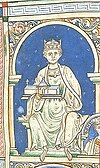 |
5 March 1133 Le Mans son of Geoffrey V of Anjou and Matilda |
Eleanor of Aquitaine Bordeaux Cathedral 18 May 1152 eight children |
6 July 1189 Chinon aged 56. Buried at Fontevraud Abbey |
Papal grant (Laudabiliter) |
| Henry the Young King (Henri le Jeune Roy) (co-ruler with his father) 14 June 1170–1183 |
 |
28 February 1155
son of Henry II and Eleanor of Aquitaine |
Margaret of France Winchester Cathedral 27 August 1172 one child |
11 June 1183 Martel, Limoges aged 28. Buried at Rouen Cathedral (Notre-Dame) |
son of Henry II (coronation as junior king) |
| Richard I Richard the Lionheart (Richard Cœur de Lion) 3 September 1189–1199 |
 |
8 September 1157 Beaumont Palace son of Henry II and Eleanor of Aquitaine |
Berengaria of Navarre Limassol 12 May 1191 no children |
6 April 1199 Chalus aged 41 from an arrow wound in the shoulder that became infected. Buried: Heart at Rouen Cathedral. Body at Fontevraud Abbey |
son of Henry II (primogeniture) |
| John Lackland (Jean sans Terre) 27 May 1199–1216 |
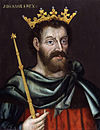 |
24 December 1166 Beaumont Palace son of Henry II and Eleanor of Aquitaine |
(1) Isabel of Gloucester Marlborough Castle 29 August 1189 no children (2) Isabella of Angoulême |
19 October 1216 Newark-on-Trent aged 49, probably from dysentery brought on by eating peaches and drinking wine. Buried at Worcester Cathedral |
brother of Richard I (appointment) |
Disputed claimant
Louis VIII of France briefly ruled about half of England from 1216 to 1217 at the conclusion of the First Barons' War against King John. On marching into London he was openly received by the rebel barons and citizens of London and proclaimed (though not crowned) king at St Paul's cathedral. Many nobles, including Alexander II of Scotland for his English possessions, gathered to give homage to him. However, in signing the Treaty of Lambeth in 1217, Louis conceded that he had never been the legitimate king of England.
| Name | Portrait | Birth | Marriages | Death | Claim |
|---|---|---|---|---|---|
| Louis The Lion 1216– 22 September 1217 Title disputed |
 |
5 September 1187 Paris son of Philip II of France, and Isabella of Hainault |
Blanche of Castile Portmont 23 May 1200 13 children |
8 November 1226 Montpensier aged 39 |
Right of conquest |
| Name | Portrait | Birth | Marriages | Death | Claim |
|---|---|---|---|---|---|
| Henry III Henry of Winchester 28 October 1216–1272 |
 |
1 October 1207 Winchester Castle son of King John and Isabella of Angoulême |
Eleanor of Provence Canterbury Cathedral 14 January 1236 nine children |
16 November 1272 Westminster Palace aged 65 |
son of King John (primogeniture) |
| Edward I Longshanks 20 November 1272–1307 |
 |
17 June 1239 Westminster Palace son of Henry III and Eleanor of Provence |
(1) Eleanor of Castile Abbey of Santa Maria la Real de Huelgas 18 October 1254 17 children (2) Margaret of France |
7 July 1307 Burgh by Sands aged 68 |
son of Henry III (primogeniture) |
| Edward II Edward of Caernarfon 7 July 1307 – 25 January 1327 |
 |
25 April 1284 Caernarfon Castle son of Edward I and Eleanor of Castile |
Isabella of France Boulogne Cathedral 25 January 1308 five children |
21 September 1327 Berkeley Castle aged 43 (murdered)[1] |
son of Edward I (primogeniture) |
| Edward III 25 January 1327–1377 |
 |
13 November 1312 Windsor Castle son of Edward II and Isabella of France |
Philippa of Hainault York Minster 24 January 1328 14 children |
21 June 1377 Sheen Palace aged 64 |
son of Edward II (primogeniture) |
| Richard II 21 June 1377 – 29 September 1399 |
 |
6 January 1367 Bordeaux son of Edward, the Black Prince and Joan of Kent |
(1) Anne of Bohemia 14 January 1382 no children (2) Isabella of Valois |
14 February 1400 Pontefract Castle aged 33 probably from starvation |
grandson of Edward III (primogeniture) |
House of Lancaster
[edit]This house descended from Edward III's third surviving son, John of Gaunt. Henry IV seized power from Richard II (and also displaced the next in line to the throne, Edmund Mortimer, a descendant of Edward III's second son, Lionel of Antwerp).
| Name | Portrait | Birth | Marriages | Death | Claim |
|---|---|---|---|---|---|
| Henry IV Bolingbroke 30 September 1399–1413 |
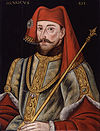 |
3 April 1366/7 Bolingbroke Castle son of John of Gaunt and Blanche of Lancaster |
(1) Mary de Bohun Arundel Castle 27 July 1380 seven children (2) Joanna of Navarre |
20 March 1413 Westminster Abbey aged 45 or 46[2] |
grandson and heir male of Edward III (usurpation/ agnatic primogeniture) |
| Henry V 20 March 1413–1422 |
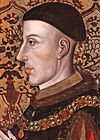 |
16 September 1386 or 9 August 1387[3] Monmouth Castle son of Henry IV and Mary de Bohun |
Catherine of Valois Troyes Cathedral 2 June 1420 one son |
31 August 1422 Château de Vincennes aged 35 |
son of Henry IV (agnatic primogeniture) |
| Henry VI (first reign) 31 August 1422 – 4 March 1461 |

|
6 December 1421 Windsor Castle son of Henry V and Catherine of Valois |
Margaret of Anjou Titchfield Abbey 22 April 1445 1 son |
21 May 1471 Tower of London aged 49 |
son of Henry V (agnatic primogeniture) |
House of York
[edit]The House of York inherited its name from the fourth surviving son of Edward III, Edmund, 1st Duke of York, but claimed the right to the throne through Edward III's second surviving son, Lionel of Antwerp.
The Wars of the Roses (1455–1485) saw the throne pass back and forth between the rival houses of Lancaster and York.
| Name | Portrait | Birth | Marriages | Death | Claim |
|---|---|---|---|---|---|
| Edward IV (first reign) 4 March 1461 – 2 October 1470 |

|
28 April 1442 Rouen son of Richard Plantagenet, 3rd Duke of York, and Cecily Neville |
Elizabeth Woodville Grafton Regis 1 May 1464 ten children |
9 April 1483 Westminster Palace aged 40 (probably died of a stroke after catching a chill during a fishing trip) |
great-great-grandson and heir general of Edward III (seizure of the crown/cognatic primogeniture) |
House of Lancaster (restored)
[edit]| Name | Portrait | Birth | Marriages | Death | Claim |
|---|---|---|---|---|---|
| Henry VI (second reign) 30 October 1470 – 11 April 1471 |

|
6 December 1421 Windsor Castle son of Henry V and Catherine of Valois |
Margaret of Anjou Titchfield Abbey 22 April 1445 1 son |
21 May 1471 Tower of London aged 49 (murdered by the York brothers). |
son of Henry V (seizure of the crown) |
House of York (restored)
[edit]| Name | Portrait | Birth | Marriages | Death | Claim |
|---|---|---|---|---|---|
| Edward IV (second reign) 11 April 1471 – 9 April 1483 |

|
28 April 1442 Rouen son of Richard Plantagenet, 3rd Duke of York, and Cecily Neville |
Elizabeth Woodville Grafton Regis 1 May 1464 ten children |
9 April 1483 Westminster Palace aged 40 (probably died of a stroke after catching a chill during a fishing trip) |
great-great-grandson and heir general of Edward III (seizure of the crown/cognatic primogeniture) |
| Edward V 9 April – 25 June 1483[4] |
 |
2 November 1470 Westminster son of Edward IV and Elizabeth Woodville[4] |
unmarried | c. 1483 London aged about 12 (reportedly smothered) |
son of Edward IV (cognatic primogeniture) |
| Richard III 26 June 1483–1485[5] |
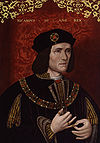 |
2 October 1452 Fotheringhay Castle son of Richard Plantagenet, 3rd Duke of York, and Cecily Neville |
Anne Neville Westminster Abbey 12 July 1472 1 son |
22 August 1485 Bosworth Field aged 32 (killed in battle) |
great-great-grandson of Edward III (Titulus Regius) |
House of Tudor
[edit]The Tudors descended matrilineally from John Beaufort, one of the illegitimate children of John of Gaunt (third surviving son of Edward III), by Gaunt's long-term mistress Katherine Swynford. Those descended from English monarchs only through an illegitimate child would normally have no claim on the throne, but the situation was complicated when Gaunt and Swynford eventually married in 1396 (25 years after John Beaufort's birth). In view of the marriage, the church retroactively declared the Beauforts legitimate via a papal bull the same year (also enshrined in an Act of Parliament in 1397). A subsequent proclamation by John of Gaunt's legitimate son, King Henry IV, also recognised the Beauforts' legitimacy, but declared them ineligible ever to inherit the throne. Nevertheless, the Beauforts remained closely allied with Gaunt's other descendants, the Royal House of Lancaster.
John Beaufort's granddaughter Lady Margaret Beaufort was married to Edmund Tudor. Tudor was the son of Welsh courtier Owain Tewdwr or Tudur (anglicised to Owen Tudor) and Catherine of Valois, the widowed queen consort of the Lancastrian King Henry V. Edmund Tudor and his siblings were either illegitimate, or the product of a secret marriage, and owed their fortunes to the goodwill of their legitimate half-brother King Henry VI. When the House of Lancaster fell from power, the Tudors followed. By the late 15th century, the Tudors were the last hope for the Lancaster supporters. Edmund Tudor's son became king as Henry VII after defeating Richard III at the Battle of Bosworth Field in 1485, ending the Wars of the Roses.
With Henry VIII's break from the Roman Catholic Church, the monarch became the Supreme Head of the Church of England and of the Church of Ireland. Elizabeth I's title became the Supreme Governor of the Church of England.
| Name | Portrait | Birth | Marriages | Death | Claim |
|---|---|---|---|---|---|
| Henry VII 22 August 1485–1509 |
 |
28 January 1457 Pembroke Castle son of Edmund Tudor and Lady Margaret Beaufort |
Elizabeth of York Westminster Abbey 18 January 1486 eight children |
21 April 1509 Richmond Palace aged 52 |
great-great-great-grandson of Edward III (right of conquest) |
| Henry VIII 21 April 1509–1547 |
 |
28 June 1491 Greenwich Palace son of Henry VII and Elizabeth of York |
Catherine of Aragon Greenwich 11 June 1509 one daughter |
28 January 1547 Whitehall Palace aged 55 |
son of Henry VII (primogeniture) |
| Anne Boleyn Westminster Palace 25 January 1533 one daughter | |||||
| Jane Seymour Whitehall Palace 30 May 1536 one son | |||||
| Anne of Cleves Greenwich Palace 6 January 1540 | |||||
| Catherine Howard Hampton Court Palace 28 July 1540 | |||||
| Catherine Parr Hampton Court Palace 12 July 1543 | |||||
| Edward VI 28 January 1547–1553 |
 |
12 October 1537 Hampton Court Palace son of Henry VIII and Jane Seymour |
unmarried | 6 July 1553 Greenwich Palace aged 15 |
son of Henry VIII (primogeniture) |
Disputed claimant
Edward VI named Lady Jane Grey as his heir presumptive, overruling the order of succession laid down by Parliament in the Third Succession Act. Four days after his death on 6 July 1553, Jane was proclaimed queen—the first of three Tudor women to be proclaimed queen regnant. Nine days after the proclamation, on 19 July, the Privy Council switched allegiance and proclaimed Edward VI's Catholic half-sister Mary. Jane was executed in 1554, aged 16. Many historians do not consider her to have been a legitimate monarch.
| Name | Portrait | Birth | Marriages | Death | Claim |
|---|---|---|---|---|---|
| Jane 10–19 July 1553 Title disputed |
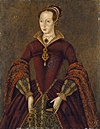 |
October 1537 Bradgate Park daughter of Henry Grey, 1st Duke of Suffolk, and Lady Frances Brandon |
Lord Guildford Dudley The Strand 21 May 1553 no children[6] |
12 February 1554 Tower of London aged 16 (beheaded) |
great-granddaughter of Henry VII (Devise for the succession) |
| Name | Portrait | Birth | Marriages | Death | Claim |
|---|---|---|---|---|---|
| Mary I 19 July 1553–1558 |
 |
18 February 1516 Greenwich Palace daughter of Henry VIII and Catherine of Aragon |
Philip II of Spain Winchester Cathedral 25 July 1554 no children |
17 November 1558 St. James's Palace aged 42 |
daughter of Henry VIII (Third Succession Act) |
| Philip[7] 25 July 1554 – 17 November 1558 (jure uxoris) |
 |
21 May 1527 Valladolid, Spain son of Charles V, Holy Roman Emperor, and Isabella of Portugal |
(2) Mary I of England Winchester Cathedral 25 July 1554 no children three other marriages and seven children |
13 September 1598 El Escorial, Spain aged 71 |
husband of Mary I (Act for the Marriage of Queen Mary to Philip of Spain) |
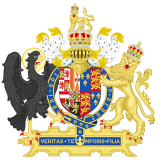
Under the terms of the marriage treaty between Philip I of Naples (Philip II of Spain from 15 January 1556) and Queen Mary I, Philip was to enjoy Mary's titles and honours for as long as their marriage should last. All official documents, including Acts of Parliament, were to be dated with both their names, and Parliament was to be called under the joint authority of the couple. An Act of Parliament gave him the title of king and stated that he "shall aid her Highness... in the happy administration of her Grace’s realms and dominions"[8] (although elsewhere the Act stated that Mary was to be "sole queen"). Nonetheless, Philip was to co-reign with his wife.[9] As the new King of England could not read English, it was ordered that a note of all matters of state should be made in Latin or Spanish.[9][10][11] Coins were minted showing the heads of both Mary and Philip, and the coat of arms of England (right) was impaled with Philip's to denote their joint reign.[12][13] Acts which made it high treason to deny Philip's royal authority were passed in England[14] and Ireland.[15] In 1555, Pope Paul IV issued a papal bull recognising Philip and Mary as rightful King and Queen of Ireland.
| Name | Portrait | Birth | Marriages | Death | Claim |
|---|---|---|---|---|---|
| Elizabeth I 17 November 1558–1603 |
 |
7 September 1533 Greenwich Palace daughter of Henry VIII and Anne Boleyn |
unmarried | 24 March 1603 Richmond Palace aged 69 |
daughter of Henry VIII (Third Succession Act) |
House of Stuart
[edit]Following the death of Elizabeth I in 1603 without issue, the Scottish king, James VI, succeeded to the English throne as James I in the Union of the Crowns. James was descended from the Tudors through his great-grandmother, Margaret Tudor, the eldest daughter of Henry VII. In 1604 he adopted the title King of Great Britain. However the two parliaments remained separate.
| Name | Portrait | Birth | Marriages | Death | Claim |
|---|---|---|---|---|---|
| James I 24 March 1603–1625 |
 |
19 June 1566 Edinburgh Castle son of Henry Stuart, Lord Darnley, and Mary I, Queen of Scots |
Anne of Denmark Oslo 23 November 1589 seven children |
27 March 1625 Theobalds House Aged 58 |
great-great-grandson and heir general of Henry VII |
| Charles I 27 March 1625–1649 |
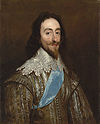 |
19 November 1600 Dunfermline Palace son of James I and Anne of Denmark |
Henrietta Maria of France St Augustine's Abbey 13 June 1625 nine children |
30 January 1649 Whitehall Palace aged 48 (beheaded) |
son of James I (cognatic primogeniture) |
Commonwealth
[edit]There was no reigning monarch between the execution of Charles I in 1649 and the Restoration of Charles II in 1660. Instead, from 1653 the following individuals held power as Lords Protector, during the period known as the Protectorate, when the monarchy was overthrown.
| Name | Portrait | Birth | Marriage(s) | Death |
|---|---|---|---|---|
| Oliver Cromwell Old Ironsides 16 December 1653–1658[16] |
 |
25 April 1599 Huntingdon[16] son of Robert Cromwell and Elizabeth Steward[17] |
Elizabeth Bourchier in St Giles[18] 22 August 1620 nine children[16] |
3 September 1658 Whitehall aged 59[16] |
| Richard Cromwell Tumbledown Dick 3 September 1658 – 7 May 1659[19] |
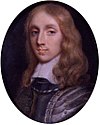 |
4 October 1626 Huntingdon son of Oliver Cromwell and Elizabeth Bourchier[19] |
Dorothy Maijor May 1649 nine children[19] |
12 July 1712 Cheshunt aged 85[20] |
House of Stuart (restored)
[edit]Although the monarchy was restored in 1660, no stable settlement proved possible until the Glorious Revolution of 1688, when Parliament finally asserted the right to choose whomsoever it pleased as monarch.
| Name | Portrait | Birth | Marriages | Death | Claim |
|---|---|---|---|---|---|
| Charles II 1660–1685[21] Recognised by Royalists in 1649 |
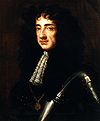 |
29 May 1630 St. James' Palace son of Charles I and Henrietta Maria of France |
Catherine of Braganza Portsmouth 21 May 1662 no children |
6 February 1685 Whitehall Palace aged 54 |
son of Charles I (cognatic primogeniture; English Restoration) |
| James II 6 February 1685 – 23 December 1688 (deposed) |
 |
14 October 1633 St. James' Palace son of Charles I and Henrietta Maria of France |
(1) Anne Hyde The Strand 3 September 1660 eight children (2) Mary of Modena |
16 September 1701 Château de Saint-Germain-en-Laye aged 67 |
son of Charles I (cognatic primogeniture) |
| Mary II 13 February 1689–1694 |
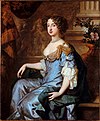 |
30 April 1662 St. James' Palace daughter of James II and Anne Hyde |
St. James' Palace 4 November 1677 no children |
28 December 1694 Kensington Palace aged 32 |
grandchildren of Charles I (offered the crown by Parliament) |
| William III William of Orange 13 February 1689–1702 |
 |
4 November 1650 The Hague son of William II, Prince of Orange, and Mary, Princess Royal[22] |
8 March 1702 Kensington Palace aged 51 after breaking his collarbone from falling off his horse | ||
| Anne 8 March 1702–1 May 1707[23] Queen of Great Britain and Ireland 1 May 1707–1 August 1714 |
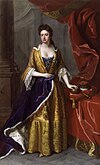 |
6 February 1665 St. James' Palace daughter of James II and Anne Hyde |
George of Denmark St. James' Palace 28 July 1683 5 children |
1 August 1714 Kensington Palace aged 49 |
daughter of James II (cognatic primogeniture; Bill of Rights 1689) |
| Monarchs after 1707 | See List of British monarchs | ||||
In 1177, as the leader of the Norman invasion of Ireland, King Henry II of England created the title of Lord of Ireland for his youngest son John, who was not then expected to succeed to any other title. John became king in 1199, and the title was held thereafter by the monarchs of England. Under the Crown of Ireland Act 1542 The Lordship of Ireland was raised into the Kingdom of Ireland. The Kingdom of Ireland continued after the Acts of Union 1707 which united the kingdoms of England and Scotland.
- From King John (of the House of Plantagenet) to King Henry VIII (of the House of Tudor), English monarchs were also Lords of Ireland.
- From King Henry VIII to Queen Anne (of the House of Stuart), English monarchs were also King or Queen of Ireland.
- From Queen Anne to King George III (of the House of Hanover), British monarchs were also King or Queen of Ireland.
- Note: In 1506 Lambert Simnel, an English pretender to the throne, was crowned Edward VI of Ireland
During the reign of George III of the United Kingdom the Kingdoms of Great Britain and of Ireland merged to become the United Kingdom of Great Britain and Ireland by the terms of the Act of Union 1800.
British monarchy to Irish monarchy
[edit]With the passage in 1931 of the Statute of Westminster, the British monarch (that is, King George V in his British council, parliament, and courts) ceased to have dominion over Ireland; only the monarch in right of Ireland had sovereignty over that realm, advised by Irish ministers and acting in his Irish parliament and courts only,[24][25] though the monarch of Ireland and the monarch of the United Kingdom (and the monarch of all the Dominions and later Commonwealth realms) were the same person. This arrangement lasted through the reigns of George V, Edward VIII, and George VI.
The Republic of Ireland Act proclaimed Ireland a republic in 1949 by removing the remaining duties of the monarch. Ireland consequently withdrew from the British Commonwealth.[26]
Northern Ireland continues as a constituent part of United Kingdom of Great Britain and Northern Ireland.
References
[edit]- ^ The date of Edward II's death is disputed by Ian Mortimer in his book "The Perfect King: The Life of Edward III, Father of the English Nation," which argues that he may not have been murdered, but held imprisoned in Europe for several more years: ISBN 0-09-952709-X
- ^ "HENRY IV - Archontology.org". Retrieved 25 October 2007.
- ^ Biography of HENRY V – Archontology.org. Retrieved 28 November 2009
- ^ a b Edward V was deposed by Richard III, who usurped the throne on the grounds that Edward was illegitimate. "EDWARD V - Archontology.org". Retrieved 25 October 2007.
- ^ "RICHARD III - Archontology.org". Retrieved 25 October 2007.
- ^ "Lady Jane Grey: Marriage". Retrieved 25 October 2007.
- ^ Philip was not meant to be a mere consort; rather, the status of Mary I's husband was envisioned as that of a co-monarch during her reign. See Act for the Marriage of Queen Mary to Philip of Spain. However the extent of his authority and his status are ambiguous. The Act says that Philip shall have the title of king and "shall aid her Highness ... in the happy administration of her Grace’s realms and dominions," but elsewhere says that Mary shall be the sole Queen.
- ^ 1 March stat. 2 c. 2
- ^ a b Louis Adrian Montrose, The subject of Elizabeth: authority, gender, and representation, University of Chicago Press, 2006
- ^ A. F. Pollard, The History of England – From the Accession of Edward VI. to the Death of Elizabeth (1547–1603), READ BOOKS, 2007
- ^ Wim de Groot, The Seventh Window: The King's Window Donated by Philip II and Mary Tudor to Sint Janskerk in Gouda (1557), Uitgeverij Verloren, 2005
- ^ Richard Marks, Ann Payne, British Museum, British Library; British heraldry from its origins to c. 1800; British Museum Publications Ltd., 1978
- ^ American Numismatic Association, The Numismatist, American Numismatic Association, 1971
- ^ Treason Act 1554
- ^ Robert Dudley Edwards, Ireland in the age of the Tudors: the destruction of Hiberno-Norman civilisation, Taylor & Francis, 1977
- ^ a b c d "Oliver Cromwell 1599–1658". Retrieved 25 October 2007.
- ^ "Oliver Cromwell – Faq 1". Retrieved 25 October 2007.
- ^ "New Page 1". Archived from the original on 29 September 2007. Retrieved 25 October 2007.
- ^ a b c "Richard Cromwell, Lord Protector, 1626–1712". Retrieved 25 October 2007.
- ^ "CROMWELL, Richard - Archontology.org". Retrieved 25 October 2007.
- ^ Britannia: Monarchs of Britain
- ^ "WILLIAM III - Archontology.org". Retrieved 25 October 2007.
- ^ "Anne (England) - Archontology.org". Retrieved 25 October 2007.
- ^ "History of Ireland > The Irish Free State (1922-1937)". Collins 22 Society. Retrieved 2 January 2011.
- ^ Cottrell, Peter (2008). The Irish Civil War 1922-23. Oxford: Osprey Publishing. p. 85. ISBN 978-1-84603-270-7.
- ^ Kondō, Atsushi (2001). Citizenship in a Global World: Comparing Citizenship Rights for Aliens. Hampshire: Palgrave. p. 120. ISBN 0-333-80265-9.
Ireland reluctantly remained a member of the Commonwealth s Irish citizens remained British Subjects. However, Irish representatives stopped attending Commonwealth meetings in 1937 and Ireland adopted a position of neutrality in World War II. Ireland became a Republic in 1949 and formally left the Commonwealth.
